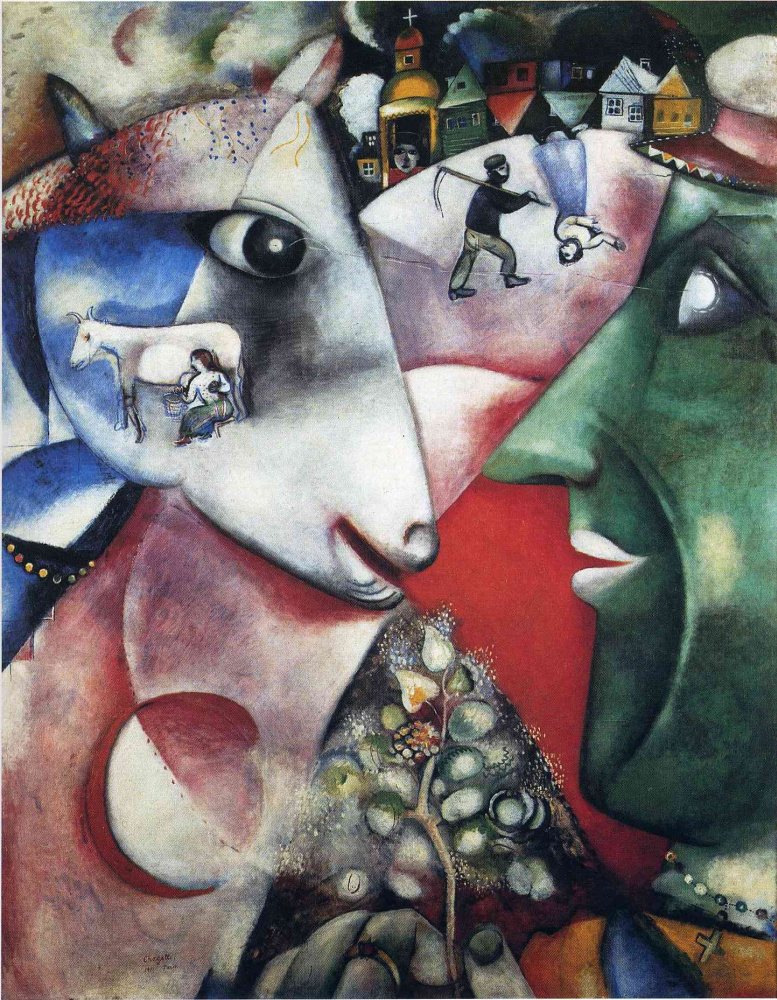log in
Enter site
Login to use Arthive functionality to the maximum
I and my village
Marc Chagall • Pintura, 1911, 191×150.5 cm
Descripción del cuadro «I and my village»
Chagall was painting a picture "I and my village" in Paris. Its plot is constructed on a mirror image. On the right we see the profile of the artist, on the contrary, the profile of a cow's muzzle. The artist hands her a bundle of branches and flowers, which is interpreted as the tree of life. At the top of the picture of the mirrored profile, like a bridge, connected the image of Vitebsk.
Chagall and the cow look, "sniff" to each other. Interesting method of "nesting dolls" allowed the artist to portray inside the head of the animal a separate scene with a milkmaid and a cow. In the center there is a circle connecting all the elements together and symbolizing the cycle of life. Around this circle and the unfolding events of the painting: houses of Vitebsk, including standing on their own roofs, a milkmaid with a cow, the inverted woman catching her man with a scythe. The bright inverted figure of a woman there is a force, it is interpreted as a symbol of fertility. She like runs away from that depicted in dark tones of a man with a scythe. Not a reference to the grim Reaper? However, this chase does not create a sense of threat, she looks like a natural part of the circle, a natural part of life. The picture fully shows characteristic of Chagall, the ability to connect the everyday and the supernatural.
In the painting "I and the village" felt the echoes of Fauvism – the laws of perspective scrapped as unnecessary, and the sizes are not concerned with the conformity of reality, cubism – the division into sectors, decomposition, impressionism is an unusual use of color. This painting is the most full of symbols: signs (Kosa, the Church, the tree of life), shape (circle, matryoshka). Many researchers define its genre as "domestic symbolism". But it is more correct to say that connecting with different areas of painting, the picture is still beyond any of them. Chagall was able to realize his goal "not to be like someone, to find your way".
Author: Alain Esaulova
Chagall and the cow look, "sniff" to each other. Interesting method of "nesting dolls" allowed the artist to portray inside the head of the animal a separate scene with a milkmaid and a cow. In the center there is a circle connecting all the elements together and symbolizing the cycle of life. Around this circle and the unfolding events of the painting: houses of Vitebsk, including standing on their own roofs, a milkmaid with a cow, the inverted woman catching her man with a scythe. The bright inverted figure of a woman there is a force, it is interpreted as a symbol of fertility. She like runs away from that depicted in dark tones of a man with a scythe. Not a reference to the grim Reaper? However, this chase does not create a sense of threat, she looks like a natural part of the circle, a natural part of life. The picture fully shows characteristic of Chagall, the ability to connect the everyday and the supernatural.
In the painting "I and the village" felt the echoes of Fauvism – the laws of perspective scrapped as unnecessary, and the sizes are not concerned with the conformity of reality, cubism – the division into sectors, decomposition, impressionism is an unusual use of color. This painting is the most full of symbols: signs (Kosa, the Church, the tree of life), shape (circle, matryoshka). Many researchers define its genre as "domestic symbolism". But it is more correct to say that connecting with different areas of painting, the picture is still beyond any of them. Chagall was able to realize his goal "not to be like someone, to find your way".
Author: Alain Esaulova


